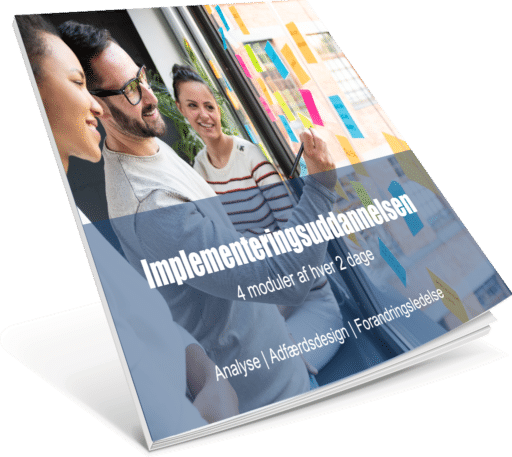You've done it before. New initiatives or changes in your institution or organization need to be implemented and it's your responsibility to make it happen. What are the criteria for your choice of approaches? Do you even realize that there are several approaches to choose from - or do you always pull the same approach and grips out of your toolbox when implementing?
This chapter argues for the necessity of a leadership focus on implementation and presents our four approaches to implementation. Read the chapter in the Leadership Pipeline book 2.0 to learn more about the levers that can be used in the different approaches.
Why is implementation so important in the public sector today?
The framework conditions for the public sector are constantly changing - and the transition and implementation of new reforms and initiatives is a major part of the management task. Many decisions and initiatives often fail to bring about the desired changes - making implementation an essential part of the daily management task. Global, political and technological volatility increases the demand for organizational agility, while expectations for productivity and quality in core services remain high. The mantra is to produce "more for less". As the public sector creates the answers to what it takes to successfully produce welfare in a time of fewer resources, there is a corresponding need to strengthen organizational change capacity and qualify implementation efforts.
The Center for Public Sector Competence Development's (COK) survey of 1,264 municipal managers in Denmark shows that 62% of managers believe that one of the biggest challenges is being able to support the implementation of change while new requirements and initiatives are constantly being added. Many public managers simply do not have the time to fully implement ongoing initiatives before they have to implement new initiatives (COK, 2015; Ahrens, 2016). If the many changes are to be realized, implementation needs to be much more focused and professional. This is to ensure that the desired change or development initiatives actually create sustainable solutions to the public sector's challenges, because there is no money to launch projects and initiatives that fail due to a lack of implementation.
Implementation as complex learning processes
Implementation is essentially a process of translating strategic intent into concrete action in daily practice that supports the desired goals. What needs to be implemented is based on decisions that are made far away from the executors, which also means that top management doesn't always know what the executors don't want and why they don't want it. This makes the task extremely challenging.

Reorganizing around daily tasks is an ongoing process that is influenced by a wide range of contextual conditions - external, organizational, social, individual, processual and communicative (Conrad, 2014). Therefore, implementation cannot be reduced to a communication task where managers communicate the changes and new goals to employees or managers at the next management level, but is more correctly understood as complex learning processes that involve both meaning-making and action coordination. Understanding the decided strategy cannot be transferred directly, but must be mobilized through the implementation process in the intersection of current and future practices - and through constant reflection on what works and what needs to be adjusted to succeed with the strategic intention.
Here we will present four different approaches to implementation that we have developed in collaboration with clients in public organizations to make it more affordable to meet the complex challenges of implementation.
Read our article on the first steps to a successful implementation here.
Want to get even better equipped to work with stakeholder analysis?
LEAD's implementation training gives you the methods to design, facilitate and lead strategic implementation processes and changes to create the impact you need.
This is an education for those who work with development, processes and change management.
Learn more about our research-based implementation training
1. The do it! approach
The Do It! approach is the approach that most of us know and associate with implementation. The approach is characterized by a high degree of centralization, where the decision about a given change is made "at the top" - often at political or executive level with the involvement of a few selected actors. The decisions must then be "put into practice", which involves new roles, new methods, new collaborative relationships and new practices. Examples include the relocation of government jobs, a new primary school reform or new quality and documentation requirements.
2. The take-it-yourself approach
The DIY approach, like the Do it yourself approach, is centralist in its form, in that it involves the implementation of initiatives that are decided centrally. But whereas the Do it! approach involves strong central control of the implementation process and requirements for implementation, the Take it Yourself approach is characterized by a solution being made available to the local units, who are responsible for the use and realization of the benefits. This could be, for example, guidance on team development, inclusive learning environments, building new features, benchmark databases, spreadsheets or pedagogical analysis tools.
3. The up-close approach
The close-by approach - While the DIY approach relies heavily on local implementation skills, the close-by approach involves dedicated support throughout the implementation process. For example, when a new IT system needs to be implemented or an important part of the core process needs to be changed. The approach is thus characterized by the involvement of a project organization (typically consisting of a steering committee and one or more project groups) that takes great responsibility for the success of the implementation process and the desired benefits.
4. We do it together approach
The We Do It Together approach is at the decentralized end of the scale. In terms of working methods and role distribution, this approach to implementation is close to co-creation, which we described in chapter 5. However, the difference is that "we do it together" usually only involves internal members of the organization, although in principle citizens/users can also be involved. From an implementation perspective, the "we do it together" approach is characterized by the fact that concrete practice changes and solutions are developed in close and equal collaboration with a high degree of involvement of actors located both centrally (in a project organization) and decentrally (managers and employees in units/departments/institutions).
What is the "right" right approach: The point is that there is no one definitive choice of implementation approach - the right approach is to tailor from the 4 approaches, according to the type of implementation and according to cultural, managerial and organizational strengths and challenges. It is a major pitfall when the choice of implementation approach is determined by the preferences and experiences of the organization or individual manager, and not based on knowledge of the task, goal and context gained through analysis in the first phases of the implementation processes. The most important thing is that the background for choices and decisions is transparent and the work is systematic. This means that approaches can be followed up and continuously evaluated for the benefit of both the current and future implementation process.

Do you want to be better at:
- Plan and execute projects that don't get derailed or scrapped halfway through
- Create greater positive measurable impact from your implementations
- Create motivation, engagement and followership among your stakeholders
- Translate strategies and decisions into behavioral goals
- Work continuously with concrete behavioral changes
- Dealing with resistance from those involved
- Use learning and benefit realization as an integral part of your implementations
Then fill out the form below and receive our description of the research-based implementation training that gives you the most powerful tools for implementation in practice.




